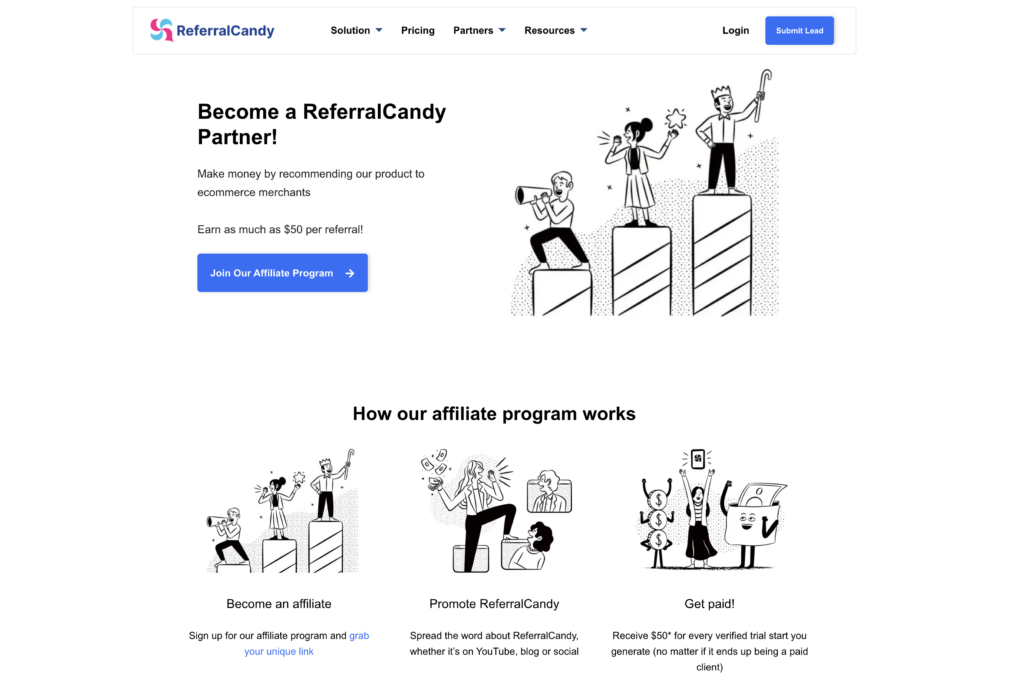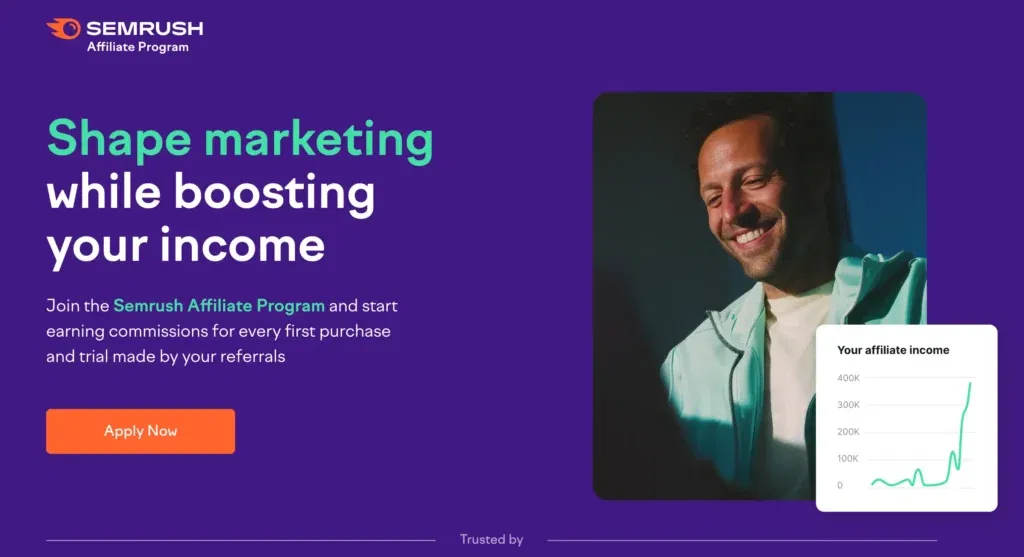Referral programs are one of the most effective ways to keep existing customers engaged with your brand while attracting new ones. What particularly draws businesses to implement customer referral programs is their potential to drive customer traffic with minimal effort on the part of the company’s marketing team.
However, not every referral program can lead to such an effect—it’s necessary to set it up so that it uses every step of the referral process in the best possible way. A referral program template provides a baseline that you can build upon and customize according to your needs.
Take a look at our comprehensive guide to learn how to use a referral program template to create robust customer referral programs.
Table of Contents
What Is a Referral Program?
A referral program is a word-of-mouth marketing strategy that encourages loyal customers to refer their family, friends, and acquaintances to your brand.
Referral marketing statistics support this approach: according to a Nielsen study, 92% of consumers trust referrals from friends or family over traditional advertising.
Nowadays, most referral programs are software-based, developed either in-house or by an external agency, and operate automatically.
How Do Referral Programs Work?

A customer referral program works by offering incentives to existing customers who choose to refer new customers to your brand, typically with the help of a referral link or code. These referrals are usually tracked using specialized software that powers your referral program.
A referral is typically logged as successful after the new customer completes an action, such as signing up or making a purchase. Rewards for successful referrals may include cash, credits, discounts, promo codes, and more.
What Are the Benefits of a Referral Program Template?
A referral program template is a set of elements designed to provide a pre-made base for your referral program that you can tweak and customize to fit your exact needs. You can find many such templates online by looking up an appropriate template for the use case you’re considering or by adapting a referral program you like.
Not only does using a template save a lot of time and effort, but it also lets you implement a tried-and-tested method rather than reinventing the wheel all over again.
The Necessary Elements of a Referral Program Template and How to Implement Them
Most referral program templates should include a number of essential elements. Here are those elements, along with tips on how to identify strong examples and implement them into your program.
1. Referral Program Headline

The headline will probably be the first element that referral prospects will see when opening the referral program. As such, the title needs to be catchy and able to capture the audience’s attention while not sacrificing any valuable information it needs to deliver.
As such, the main headline ought to be simple and to the point while also describing the advantages gained by referring a friend. A supporting headline also helps generate additional interest or add any information that might have cluttered up the main headline.
Bokksu, for instance, went with a simple “Give X, get Y” formula. It looks simple, but it lets people know exactly the main terms of the deal from just the headline.
2. Attractive Visual Identity

Your referral page should ideally have a striking, attractive visual identity that stands out from the rest of the website while also remaining recognizably close to your brand’s visual identity.
Clever usage of icons and symbols to help your current customers understand the referral process can also present a great opportunity to combine aesthetics and function.
We found that ReferralCandy, a referral marketing suite, has a referral program landing page that effectively uses visuals to demonstrate all of the program’s important points without overwhelming the viewer.
You can also check out our blog post for some extra examples of what makes an effective referral landing page.
3. Referral Program Overview

The main body of your program’s landing page should include a detailed overview of the program’s terms, features, and benefits. At the same time, it’s crucial to avoid overwhelming the reader with too much text or a bad layout.
Hiver’s referral page is a fantastic example of how a landing page should look like. It gives away all the essential info with short, to-the-point sentences and a nice use of visuals while delegating the rest to a drop-down FAQ section that doesn’t create any clutter.
4. Referral Link or Code

Referral links and codes are given to referral program members after they join. To refer new customers, they need to share the link or code with them. The referral will be logged as successful after the referred friends use the link or code to register or make a purchase.
The most important factor to consider with customer referrals is to avoid making them unwieldy and impractical—never make them too long. Personalization is also a nice touch: a customer’s referral code or unique referral link can include their name or another personal signifier in combination with a string of random numbers of characters.
ClickUp’s referral program does this very elegantly—the unique referral link includes the sender’s name and a series of numbers.
5. Call to Action

The purpose of a call to action (CTA) is to encourage customers who find themselves on the referral program page to take action by joining the program and starting to make referrals. As such, it needs to be quick, catchy, and punchy.
These CTAs are usually in the form of a link or button that serves as the centerpiece of the referral program page—it should be striking to the eye and immediately discernible from the rest of the page.
Don’t necessarily worry if your CTA copy isn’t groundbreaking. Take Google, for example; they use a simple “Join Now” CTA for their Workspace referral program but made sure to include the button five times on a relatively short page. And the blue button, coupled with the white page background, guarantees your eye will fall on one of the CTAs without fail.
6. Referral Program Rewards

After all, rewards are the chief reason why your customers will be interested in joining the referral program and referring their friends, family, and acquaintances to your brand. Therefore, it is necessary to attract attention to the rewards through strategically placed banners or other visual cues.
The rewards themselves need to be attractive enough to make the referrals worth the effort. Consider implementing a system of tiered rewards to encourage customers to keep pushing their limits.
The cash transfer service Wise became famous for its bold referral bonus, promising a cash payment of up to £75 for three friend referrals that made transfers worth over £200 each. Despite the generosity of this bonus, Wise has been turning a positive profit margin for four years straight.
Customer Referral Program Template Example
Feel free to use this quick template to start building your own program.
| Program Headline | Capture customers’ attention with a simple, clear statement (e.g., “Refer a Friend, Get Rewards!”). Optional: Add a catchy tagline below that conveys a powerful benefit (e.g., “Earn cash for every successful referral!”). |
| Visual Identity | Ensure your referral page visually aligns with your brand’s style, and use engaging visuals to simplify the referral process for customers. |
| Program Overview | Outline key features, terms, and benefits of your program in short, easy-to-read sentences. |
| Referral Link or Code | Provide each participant with a simple and personalized referral link or code. |
| Call to Action (CTA) | Use clear and compelling language (e.g., “Join Now!” or “Start Referring!”). Make the CTA button prominent on the page by using contrasting colors or even including it multiple times on the landing page. |
| Referral Program Rewards | Clearly outline the rewards for successful referrals (e.g., cash, discounts, or tiered incentives) and use visuals to highlight the perks. |
Contact Vivian Agency for Help With Your Referral Program!
Now, you probably have a better idea of how to choose and customize a referral program template to your exact needs and how to get started with building a referral program. Still, it remains a complex task that may often be overwhelming, especially if you’re running a new business and time, money, and resources are scarce.
If you need help with building your referral program, feel free to contact us at Vivian Agency—we’re proven experts at helping businesses get the most out of their affiliate networks and certainly have ideas on how to help you develop your referral program in a way that’s best for you. Alternatively, you can just book a call right away, and we can discuss this live!




